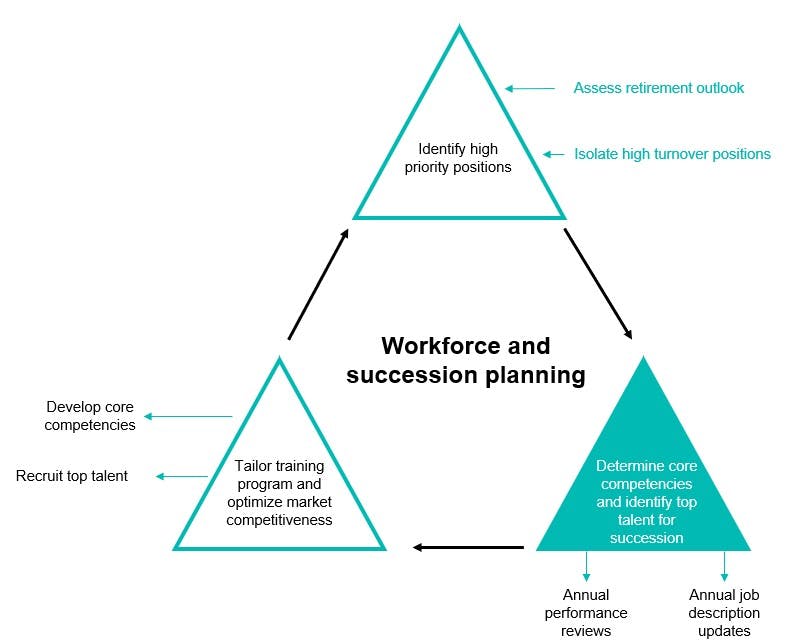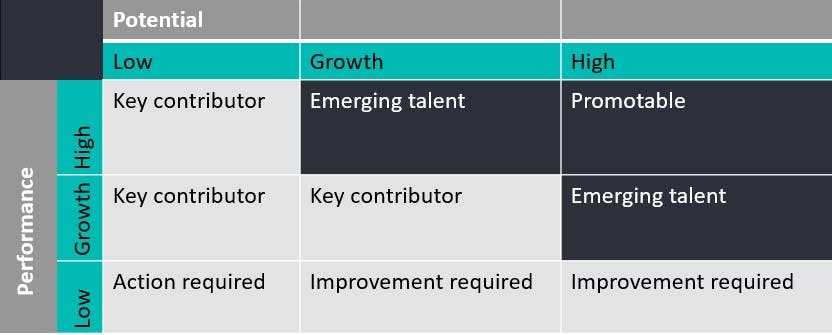Operational integration: Many of the actions required in this step can be incorporated into a classification and compensation study and an organizational assessment. If your public sector or not-for-profit organization plans to conduct either review in the near future, consider building these steps into the scope of the request for proposal (RFP) to use your resources more efficiently.

Workforce and succession planning – part 2: core competencies and top talent
Authored by Caitlin Humrickhouse and Allison LeMay
Adoption of a cyclical workforce and succession planning program is key for developing a thriving human capital management approach for government entities, public utilities, and not-for-profit organizations.
Part one of Baker Tilly’s three-part workforce and succession planning series describes how organizations can immediately implement their workforce and succession plans. Through careful budgeting and planning of resources, this can be made into a recurring part of your organization’s yearly work plan.
In part two of the series, it’s time to take a look at incorporating the next stage of workforce and succession planning — reviewing position core competencies and identifying top talent for succession — into your public or not-for-profit organization’s regular business operations. The diagram below provides an overview of a workforce and succession planning process and the key steps that tie into a successful program.

Step 1: Reviewing core competencies of critical positions
An opportune time to identify and review the core competencies associated with your organization’s critical positions is during your annual job description review. Used effectively, job descriptions serve as the base for recruitment, performance evaluations and training; they can inform almost every part of the employee life cycle. As such, human resources staff, supervisors and employees should participate in an annual review of job descriptions to ensure they are up-to-date and accurate. Employees know best what they do, supervisors know best what they should do, and human resources staff has the technical expertise to provide guidance and assure compliance. During this annual review, human resources and supervisors can intentionally define and incorporate core competencies (or review core competencies that already exist) into the job descriptions of critical positions.
Competencies — skills, knowledge, attributes, or characteristics serve as the foundation for someone being successful in the position. Competencies may be clustered in a variety of ways dependent on an organization’s needs. Examples of competency clusters include:
- Personal effectiveness competencies: Often described as “soft skills,” personal effectiveness competencies serve as the base for other competencies. The basic criteria for evaluation are not position-specific. Examples include self-development, flexibility and adaptability, ability to learn, and interpersonal skills.
- Academic competencies: Skills and knowledge acquired through academic training that serve as the base for academic competencies. Examples include critical and analytical thinking, reading and writing skills, research skills, communication skills, IT skills (ability to navigate basic IT functions), and field of study (e.g. accounting, engineering).
- Workplace competencies: Related to a position’s business functions within the organization such as the “office” side and “leadership” side of management or alternatively, fieldwork conditions for a laborer. Examples include ethics, teamwork, business fundamentals, planning, organizing and scheduling, and problem-solving.
- Industry-wide or sector-specific competencies: Specialized knowledge or technical competencies required to competently execute the position’s functions. Examples include safety skills and knowledge, industry principles, concepts, and regulations.
Think of the different competency clusters and then envision what effective execution of that competency would look like or the skillset required to meet that competency. If your organization has a core competency structure, incorporate those competencies into your definitions as well. The identified actions and skillsets should be included as essential job functions and qualifications within the job description. Repeat this process annually, paying particular attention to positions that have been consolidated or if your organizational structure has changed.
Step 2: Identifying top talent for succession
As a next step in developing your organization’s succession/workforce plan, consider your annual performance review process. By modifying the performance review to include a 9-box grid, you can identify employees that are immediately ready for the position if it became available now, and candidates that need further development and training, and allow you to assess their readiness to begin that development and training. The 9-box grid plots performance against potential and provides supervisors with defined assessment criteria to position an employee within one of the nine boxes to calibrate readiness for future development. In the 9-box grid below, individuals evaluated to be in the upper right corner (darkly shaded boxes) are identified as high-potential candidates.

An easy addition to the semi-annual performance review process, the 9-box grid is a tool for organizations to identify top talent across departments and build the organization’s internal talent bench.
Step 3: Building your talent bench
In Step 2, supervisors and human resources staff collaborate to define position competencies and identify high performers across the organization. Step 3 combines this information to identify the “bench” for each critical position — in other words, the staff members to target for future development and training to ready them for filling those advanced roles within the organization. This step can also identify if your organization does not have anyone identified for readiness, and where external recruitment may be needed.
When building the bench, supervisors, human resource leads, and executive leadership weigh the development of the core competencies with the readiness for future development and training as indicated by an individual’s 9-box grid assessment. When building your bench, keep in mind:
- Moving the person who sits directly below the critical position in your organizational structure into the open role does not guarantee they are the most qualified person for the job. To ensure a position is filled with the most qualified candidate, offer career paths for employees that allow top talent to move horizontally and vertically throughout the organization.
- Succession candidates do not have to come from the same department where the vacancy sits. When building your bench, use identification of similar core competencies to identify candidates from other units within the organization.
- Workforce and succession planning involves preparing employees for possible future roles; it is not about pre-selection. This process is intended to match the organization’s needs with the employee’s interests and prepare employees for future roles.
- Don’t put all your eggs in one basket. When possible, identify multiple individuals as candidates for each critical position.What’s next? Tailoring training and building market competitiveness
- As noted, if a critical position does not have multiple candidates or has no identified candidates, develop an external recruitment strategy so when the position does become vacant, you can quickly begin recruitment.
Remembering these guidelines will help your organization assess all employees and possibly identify individuals who may not be obvious candidates. When considering the competencies and best fit for positions, supervisors should also note any gaps in the competencies of the individuals on the bench.
What’s next? Tailoring training and building market competitiveness
In the final article of Baker Tilly’s three-part series on workforce and succession planning, government entities, public utilities, and not-for-profit organizations will learn how to optimize training programs to mitigate core competency gaps, build market competitiveness to recruit top talent and assess progress to repeat the workforce/succession planning program cycle.
Check out the full workforce and succession planning series:
For more information on this topic, or to learn how Baker Tilly workforce and succession planning specialists can help, contact our team.
